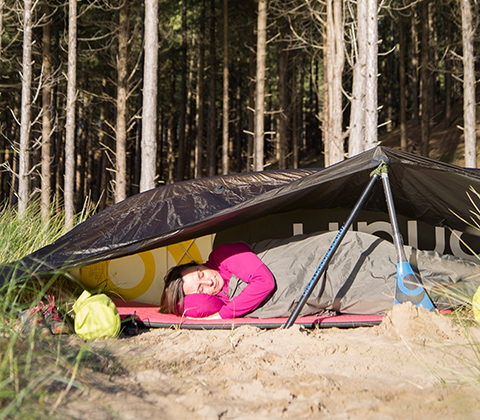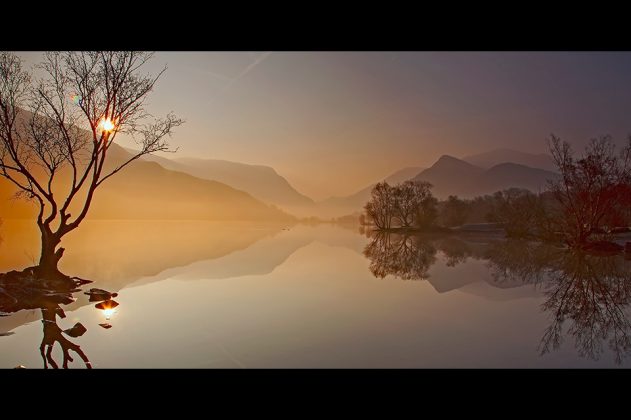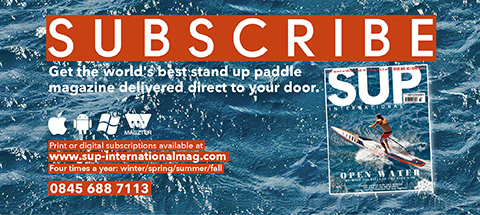GET PSYCHED #2 –
SLEEPING UNDER CANVAS
With – Sian Sykes
Enjoy the tranquility of being at one with your surroundings, watch the sun disappear over the horizon, listen to the owls and watch the stars light up the sky as you take comfort snuggling into your sleeping bag. These are the moments we live for and cherish.
I was first introduced to wild camping when I was only 4 weeks old, obviously I can’t remember, but I guess it’s a part of me and I have been camping ever since, a little nomad under canvas.
Planning your first overnight camp all depends upon the type of ‘memorable experience’ you want. Last issue we covered weather, access and communications, so let’s get straight into the fun stuff…
PACK RIGHT
If you are doing a walk in, consider what you need to take. The key is to travel light for your first overnight camp. I am a big fan of dry bags; as the name suggests, they keep things dry and compressed too. I remove unnecessary packaging on food. When packing, the knack is to minimise the weight of each individual item, so that overall there is a weight reduction. For wild camping, ideally take a one-man tent, tarp and / or a bivvy bag. When I go super lightweight, I sleep on my SUP in a bivvy bag with a tarp over me if the weather is bad. With a tarp you can actually use your SUP as a nifty prop too.
Here is my recommended kit list:
• Shelter – one man tent or tarp and or bivvy bag
• Sleeping bag – pros and cons of synthetic or down sleeping bags? I personally prefer down sleeping bag as it keeps me warm, however if it gets wet you will have a miserable night’s sleep! I also use a bivvy bag to help keep it dry.
• Sleeping bag liner – a bit of luxury if you go for silk. Keeps your sleeping bag clean and gives an extra bit of warmth.
• Mat – This is all dependent upon where you are thinking of camping. I use my SUP as my mat if I’m travelling super light weight. Sometimes I take a “Gucci” type inflatable mat which is also lightweight. It doesn’t like rocks though, so I carry a repair kit
• Warm jacket – Think of layers to keep you toasty when the sun goes down
• Shoes – to wear around the camp in the evening
• Lightweight rain jacket – I use my paddling jacket
• Hat and gloves
• Head torch and spare batteries – it’s not for just in case of an emergency; you’ll definitely be spending a lot of time in the dark
• Map and compass – please make sure you know how to use them! Tide info, if appropriate, and weather forecast
• Penknife
• Food and snacks
• Repair kit – gaffer tape is essential for any repairs
• First aid kit
• Stove – preferably small, light and simple, I use a Jetboil, which is quick and self-contained
• Fuel – bring enough, but not litres of the stuff
• Cup – I personally use a water bottle such as Nalgene. Also it doubles up as a hot water bottle
• Fork/spoon or a ‘spork’
• Lighter – a couple in fact, in a sealed bag.
• Toothbrush and toothpaste – you will be grateful for packing this
• Spare dry socks and thermal leggings – for camps in cold or wet weather
• Toilet roll and collapsible trowel – more than you’d expect for one day. Also see sanitation below
• Hand sanitiser
“ Get off the beaten track and avoid the popular honeypot ‘wild’ camping areas. Personally I feel the best camps are in solitude. It is an amazing feeling paddle boarding and pitching a tent to enjoy the wilderness and silence ”
CHOOSING YOUR CAMPING SPOT
Get off the beaten track and avoid the popular honeypot ‘wild’ camping areas. Personally I feel the best camps are in solitude. It is an amazing feeling paddleboarding and pitching a tent to enjoy the wilderness and silence. It brings a wonderful sense of escape and reconnecting with nature.
Dry pitch. Ensure you don’t camp too close to the water’s edge! A nice dry pitch is essential. If camping on a beach, make sure you are well above the tide line, don’t get caught out. Also be wary when pitching close to streams, unexpected rain causes the water level to rise overnight.
Flat pitch. Any lumps and bumps will make for an uncomfortable night’s sleep. Remember to pitch with your head uphill!
Shelter. Avoid being too exposed. Any sort of breeze makes lightweight tents sound as if you are in a tumble dryer. You will be guaranteed a miserable night’s sleep.
Sanitation. Think where your toilet is going to be. It needs to be 30m away from a water source. Please remember the ‘leave no trace’ code. Carry out tampons, sanitary towels and used toilet paper in a zip lock freezer bag. Burying doesn’t work as animals will dig things up. For us women, I highly recommend the Moon Cup, toxin free, eco friendly and easy to use too.
View. Find a spot with a lovely view. Failing that you should try and pitch where you can catch the evening rays or if you’re a morning person, facing east in order to enjoy and benefit of the sun rise.

DON’T ROUGH IT
Spare shoes – Remember spare shoes to wear around camp as your feet or paddling shoes will be wet from paddling!
Cotton t-shirts – Avoid wearing cotton t-shirts when out on the water paddleboarding. When cotton gets wet it stays wet and you will get cold.
Waterproof – Potentially you might fall into the water during your SUP adventure and you therefore need to make sure the kit you carry on the paddleboard doesn’t get wet and it is sealed in waterproof bags.
Keeping warm – If you get cold or soggy, set up camp to warm up by putting on dry clothes and having something warm to drink. This will reduce any chances of hyperthermia. Depending on weather conditions, I wear dry trousers and jacket to keep safe on the water and change when I get into camp into my ‘lounge wear’.
Beware of the mighty midges – Nothing can ruin a camping trip more utterly than a million merciless midges. The good news is that even a light breeze can keep them at bay, so look for a place that is somewhat exposed to the wind to avoid the bloodsuckers.
Tips for a smooth night
Food – What food are you going to take with you? I pre-cook food and take it with me. You can get boil in the bag foods too.
Water – If you’re on an overnight sea camp, you will have to carry enough water for cooking, drinking and washing. If you’re inland, running water it is generally safer than still water, the water is best collected as close as possible to the source. You need to boil the water for four minutes or use some kind of purification treatment to avoid getting poorly.
Hygiene – Wash and clean hands before handling food or eating, and after using the toilet.
Be inconspicuous – A green tent, bivvy or tarp may blend into the landscape better than a brightly coloured tent. The key thing is to pitch late and leave early.
Rescues – Are you fully skilled with self and peer rescues? Are you first aid trained?
Fires – These can be highly destructive. Apart from the risks to you, wild fires can be very damaging to wild life and vegetation. If I’m camping on a beach, I dig out a fire pit in the sand or pebbles. After the fire has died, I cover it up with sand/pebbles to follow the no trace code. In a mountain environment I would not have a fire. To keep toasty I wear my down jacket.
Litter – If you brought it all in you should be able to take it all out! Carry out all litter including biodegradable material. Pay heed to the ‘no trace’ code.
Gas – Shake the gas can before connecting it up to your stove. Sometimes cold weather can cause it to settle.
Make someone aware of your plans – Tell somebody where you are going and when you’ll be back. And then go! I have known of someone who nearly had the RNLI looking for them whilst they were at home…
In an emergency – If you need to make an emergency call but have a poor or no signal, moving location by just a few feet can make a difference. Moving to higher and a more open location will give a better chance of having a signal. When a voice call is impossible, you may be able to squeeze through a text message.
Head torch – As soon as you set up camp, put your head torch on your head otherwise it will get dark you will not be able to find it.
Clean camp – Make sure after cooking, you clean up and put everything in your tent to discourage animals paying a visit in the night for a drive through feed!
Wild camping is completely legal in Scotland. Elsewhere in the world, nobody has complained or been in the slightest bit concerned. My advice is as long as you’re not on private land, near someone’s home, or otherwise being annoying you should be fine, just pitch late and leave early, leaving no trace and avoid camping near foot paths. SUP
ABOUT SIAN
Sian is a fully qualified International Mountain Leader and SUP instructor in Wales, UK and runs her own business Psyched Paddleboarding. Sian has travelled the world, building up vast experience of leading expeditions to Nepal, Mongolia, India, China, Peru, Morocco, Iceland, Europe and the Alps. Sian’s mission is to inspire others to SUP and to offer high quality SUP training and safety advice. She offers memorable stand up paddle boarding adventures whether hiking to a tranquil wilderness lake, exploring stunning coastlines and of course leading SUP expeditions.


